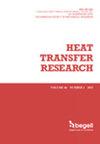Numerical investigation of mixed convection of non‐Newtonian fluid in a vented square cavity with fixed baffle
IF 1.6
4区 工程技术
Q3 THERMODYNAMICS
引用次数: 0
Abstract
This paper numerically investigates mixed convective heat transfer in a vented square cavity incorporated with a baffle that is subjected to external non‐Newtonian fluids (NNFs). Adiabatic conditions are imposed on the top and bottom walls, while cold temperature conditions are applied to the right and left solid boundaries. Heated NNF enters the cavity through the inlet and goes out through the outlet at three different locations, and it passes on a vertical baffle fixed at the base placed at different lengths. To examine the impact of the inlet and outlet positions, three different shapes of the outlet port located on the right wall and the inlet port on the left bottom wall were investigated. The impacts of Reynolds number (Re) of 100 ≤ Re ≤ 1000, Richardson number (Ri) of 0.1 ≤ Ri ≤ 3, power law index (n) of 0.6 ≤ n ≤ 1.4, length of baffle (Lb) of 0.2 ≤ Lb ≤ 0.6 and the outlet hole positions (S) of on the thermal and flow distributions in the cavity are taken into consideration in this paper. The results demonstrated that the flow's intensity and heat transfer increase with improvement in the Re and n at any baffle length. When the Ri increased from 0.1 to 3, increased by 23.3% at , and 13.8% at . Also, the Ri increment results in the augmentation of the average heat transfer.非牛顿流体在带固定挡板的方形通风腔内混合对流的数值研究
本文数值研究了受外部非牛顿流体(NNFs)作用的带有挡板的方形通风腔内的混合对流换热。绝热条件施加于顶壁和底壁,而冷温度条件施加于左右固体边界。加热后的NNF通过入口进入空腔,并在三个不同的位置通过出口,并通过固定在底座上的垂直挡板,挡板的长度不同。为了检验进口和出口位置的影响,研究了三种不同形状的出口位于右壁和进口位于左底壁。本文考虑了雷诺数(Re)为100≤Re≤1000、理查德森数(Ri)为0.1≤Ri≤3、幂律指数(n)为0.6≤n≤1.4、挡板长度(Lb)为0.2≤Lb≤0.6和出口孔位置(S)对腔内热流分布的影响。结果表明,在任意挡板长度下,随着雷诺数和雷诺数的增加,流动强度和换热量均增加。当Ri由0.1增加到3时,at增加23.3%,at增加13.8%。同时,Ri的增加使平均换热量增大。
本文章由计算机程序翻译,如有差异,请以英文原文为准。
求助全文
约1分钟内获得全文
求助全文
来源期刊

Heat Transfer Research
工程技术-热力学
CiteScore
3.10
自引率
23.50%
发文量
102
审稿时长
13.2 months
期刊介绍:
Heat Transfer Research (ISSN1064-2285) presents archived theoretical, applied, and experimental papers selected globally. Selected papers from technical conference proceedings and academic laboratory reports are also published. Papers are selected and reviewed by a group of expert associate editors, guided by a distinguished advisory board, and represent the best of current work in the field. Heat Transfer Research is published under an exclusive license to Begell House, Inc., in full compliance with the International Copyright Convention. Subjects covered in Heat Transfer Research encompass the entire field of heat transfer and relevant areas of fluid dynamics, including conduction, convection and radiation, phase change phenomena including boiling and solidification, heat exchanger design and testing, heat transfer in nuclear reactors, mass transfer, geothermal heat recovery, multi-scale heat transfer, heat and mass transfer in alternative energy systems, and thermophysical properties of materials.
 求助内容:
求助内容: 应助结果提醒方式:
应助结果提醒方式:


